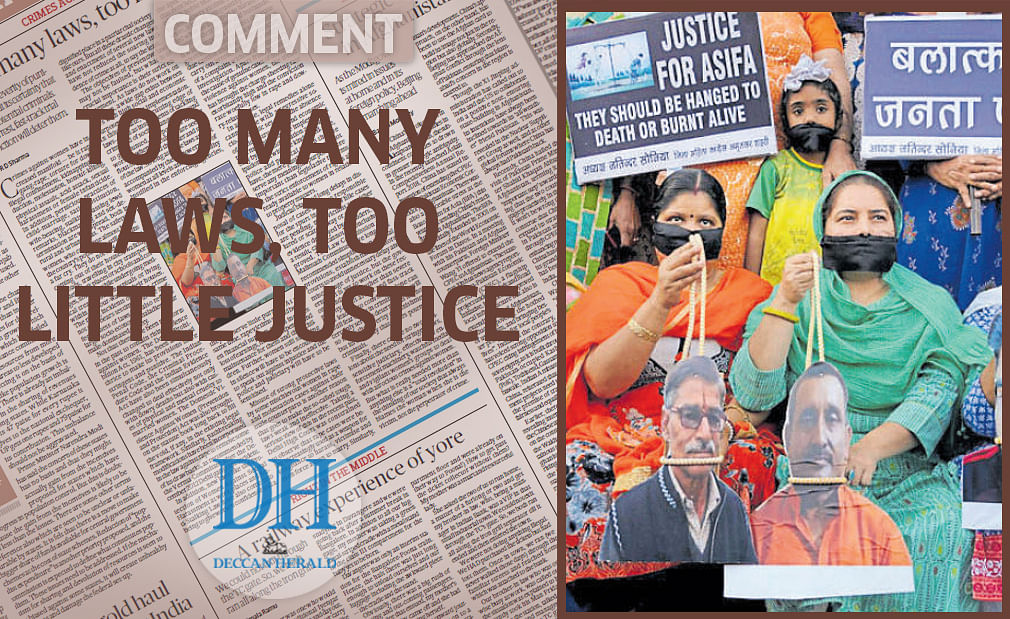Crimes against women have increased manifold — be it rape, gang-rape, torture for dowry, illegal confinement, kidnapping, abduction, molestation, honour-killing, physical assault, acid attack, sexual harassment or female infanticide. In addition, pernicious practices of child-marriage, sati, prostitution, wife-beating, stalking, passing lewd remarks, blackmailing and sex-determination are widespread, both in rural and urban areas. The safety of women, who constitute almost half of the country’s population, still remains a far cry. They do not feel safe while coming out of their houses, walking on roads, travelling in city transport, at their workplaces or schools and colleges, nor even while undergoing medical treatment in hospitals or living within the four walls of their houses. The rising incidents of gender-crime not only bears testimony to the ineffectiveness of laws but also reflects larger socio-economic maladies in our male-dominated society.
Not that there have been no efforts in the past to contain rising violence against women. The Dowry Prohibition Act, 1961, has been amended thrice to make its provisions more stringent and punitive. The Indian Penal Code, the Criminal Procedure Code and the Indian Evidence Act have also been simultaneously changed to deal effectively not only with dowry deaths but also with cases of physical and mental cruelty to married women. The Domestic Violence Against Women (Prevention and Protection) Act was also brought on the statute book long back to fill the void, if any, within the existing legal framework. Similarly, pathbreaking modifications have been incorporated in the law against rape to remove some of its drawbacks, as recommended by the Verma Committee after the December 2012 Delhi gangrape incident.
In addition, new laws like the Protection of Women Against Sexual Harassment at workplaces and Anti-Stalking Law have also come into being to give women confidence and a dignified place in a patriarchal society like ours. But all these drastic changes and enactment of several new laws have not reduced the soaring incidence of crime at all, to say the least.
The objectives of preventive laws may not be faulted, but what is of crucial importance is their strict enforcement. As laws do not work on their own, a wide gap exists between laws with high social and economic purposes and their implementation. In this climate, the cutting edge of laws -- both as instruments of tackling crime and of social change -- is bound to get blunted. The position further worsens when the culprits are seen to flout or get around the letter and spirit of the law. So long as these laws are not accompanied by the empowerment of women at all levels and accountability instilled in the enforcing agencies, they will serve little purpose. At the same time, rape victims should be given financial support, which includes loss of earnings, medical expenses and maintenance for them and their children. Further, women still suffering in silence will have to be encouraged to speak out against injustice and the police and judiciary will have to be sensitised.
Misuse of strong protective laws by some mischievous women in rape and molestation cases against their male counterparts is another reason that goes to make the so-called tough laws weak and ineffective. Taking a serious view of this in the recent past, Delhi High Court was constrained to observe that rape cases were being increasingly used as a weapon for vengeance to harass, victimise and even force a man to marry. Similarly, the apex court, too, rightly observed that even Section 498A of IPC, enacted with noble intentions to protect hapless dowry victims and battered wives, is largely being used by disgruntled wives as a weapon to harass and victimise their in-laws and husbands. It was compelled to direct the state governments and police to exercise due caution and not to automatically carry out the arrest on the mere lodging of a complaint without a preliminary investigation. Apart from harming the cause of genuine cases of domestic violence against women, the trend has brought the charge-sheeting rate exorbitantly high and the conviction rate woefully low in rape and dowry-related cases.
In any case, legal remedies alone cannot cope with a regressive socio-economic set-up in the absence of radical structural and economic reforms which can be implemented only by mass mobilisation and participation. But with the kind of red-tape, police and political set-up that we have, the mere passing of laws will not serve any meaningful purpose. More important than legislative reforms is the strict enforcement of rights already available to women in relation to property matters.
Judicial bias and long delays in disposal of cases are also responsible for the spurt in crimes. While cases are pending, most victims are either lured or scared away or the relevant evidence destroyed by offenders. As a result, cases cannot be conclusively proved. The Law Commission and Malimath Committee have long back recommended simplification of penal provisions, the establishment of more courts to avoid unnecessary delay and miscarriage of justice, but the government is yet to work on these recommendations. Rather than a severe penalty, swift arrest and fast-track trial leading to conviction alone can instil fear of law in criminals. This will certainly serve as a deterrent as it is not so much the severity of punishment but its certainty that deters potential criminals.
Finally, there can be no two opinions about the need for stringent laws, sensitive judiciary, effective law enforcement machinery, watchful media and vigilant women’s groups to deal with atrocious crimes against women. But what is really needed more than anything else is a “total revolution” in the thinking of our society that always blames the woman when she is the victim, not the perpetrator of the crime.
